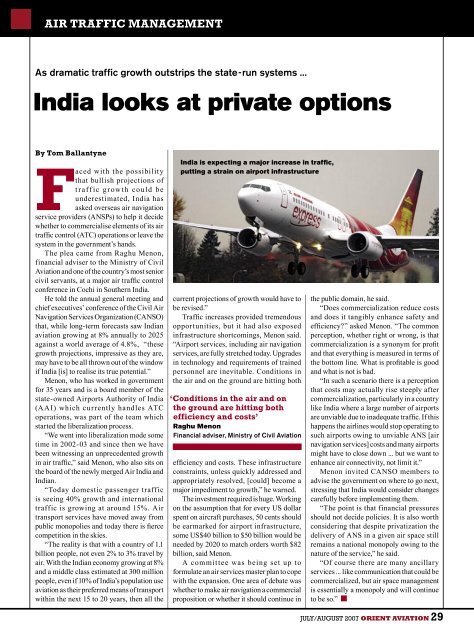Malaysia Airlines - Orient Aviation
Malaysia Airlines - Orient Aviation
Malaysia Airlines - Orient Aviation
Create successful ePaper yourself
Turn your PDF publications into a flip-book with our unique Google optimized e-Paper software.
AIR TRAFFIC MANAGEMENT<br />
As dramatic traffic growth outstrips the state-run systems ...<br />
India looks at private options<br />
By Tom Ballantyne<br />
Faced with the possibility<br />
that bullish projections of<br />
t raf f ic g row t h could be<br />
underestimated, India has<br />
asked overseas air navigation<br />
service providers (ANSPs) to help it decide<br />
whether to commercialise elements of its air<br />
traffic control (ATC) operations or leave the<br />
system in the government’s hands.<br />
The plea came from Raghu Menon,<br />
financial adviser to the Ministry of Civil<br />
<strong>Aviation</strong> and one of the country’s most senior<br />
civil servants, at a major air traffic control<br />
conference in Cochi in Southern India.<br />
He told the annual general meeting and<br />
chief executives’ conference of the Civil Air<br />
Navigation Services Organization (CANSO)<br />
that, while long-term forecasts saw Indian<br />
aviation growing at 8% annually to 2025<br />
against a world average of 4.8%, “these<br />
growth projections, impressive as they are,<br />
may have to be all thrown out of the window<br />
if India [is] to realise its true potential.”<br />
Menon, who has worked in government<br />
for 35 years and is a board member of the<br />
state-owned Airports Authority of India<br />
(AAI) which currently handles ATC<br />
operations, was part of the team which<br />
started the liberalization process.<br />
“We went into liberalization mode some<br />
time in 2002-03 and since then we have<br />
been witnessing an unprecedented growth<br />
in air traffic,” said Menon, who also sits on<br />
the board of the newly merged Air India and<br />
Indian.<br />
“Today domestic passenger traffic<br />
is seeing 40% growth and international<br />
traffic is growing at around 15%. Air<br />
transport services have moved away from<br />
public monopolies and today there is fierce<br />
competition in the skies.<br />
“The reality is that with a country of 1.1<br />
billion people, not even 2% to 3% travel by<br />
air. With the Indian economy growing at 8%<br />
and a middle class estimated at 300 million<br />
people, even if 10% of India’s population use<br />
aviation as their preferred means of transport<br />
within the next 15 to 20 years, then all the<br />
India is expecting a major increase in traffic,<br />
putting a strain on airport infrastructure<br />
current projections of growth would have to<br />
be revised.”<br />
Traffic increases provided tremendous<br />
opportunities, but it had also exposed<br />
infrastructure shortcomings, Menon said.<br />
“Airport services, including air navigation<br />
services, are fully stretched today. Upgrades<br />
in technology and requirements of trained<br />
personnel are inevitable. Conditions in<br />
the air and on the ground are hitting both<br />
‘Conditions in the air and on<br />
the ground are hitting both<br />
efficiency and costs’<br />
Raghu Menon<br />
Financial adviser, Ministry of Civil <strong>Aviation</strong><br />
efficiency and costs. These infrastructure<br />
constraints, unless quickly addressed and<br />
appropriately resolved, [could] become a<br />
major impediment to growth,” he warned.<br />
The investment required is huge. Working<br />
on the assumption that for every US dollar<br />
spent on aircraft purchases, 50 cents should<br />
be earmarked for airport infrastructure,<br />
some US$40 billion to $50 billion would be<br />
needed by 2020 to match orders worth $82<br />
billion, said Menon.<br />
A committee was being set up to<br />
formulate an air services master plan to cope<br />
with the expansion. One area of debate was<br />
whether to make air navigation a commercial<br />
proposition or whether it should continue in<br />
the public domain, he said.<br />
“Does commercialization reduce costs<br />
and does it tangibly enhance safety and<br />
efficiency?” asked Menon. “The common<br />
perception, whether right or wrong, is that<br />
commercialization is a synonym for profit<br />
and that everything is measured in terms of<br />
the bottom line. What is profitable is good<br />
and what is not is bad.<br />
“In such a scenario there is a perception<br />
that costs may actually rise steeply after<br />
commercialization, particularly in a country<br />
like India where a large number of airports<br />
are unviable due to inadequate traffic. If this<br />
happens the airlines would stop operating to<br />
such airports owing to unviable ANS [air<br />
navigation services] costs and many airports<br />
might have to close down ... but we want to<br />
enhance air connectivity, not limit it.”<br />
Menon invited CANSO members to<br />
advise the government on where to go next,<br />
stressing that India would consider changes<br />
carefully before implementing them.<br />
“The point is that financial pressures<br />
should not decide policies. It is also worth<br />
considering that despite privatization the<br />
delivery of ANS in a given air space still<br />
remains a national monopoly owing to the<br />
nature of the service,” he said.<br />
“Of course there are many ancillary<br />
services ... like communication that could be<br />
commercialized, but air space management<br />
is essentially a monopoly and will continue<br />
to be so.”<br />
JULY/AUGUST 2007 ORIENT AVIATION 29








![OAMag-V7N4-Cover [Converted] - Orient Aviation](https://img.yumpu.com/48598575/1/190x255/oamag-v7n4-cover-converted-orient-aviation.jpg?quality=85)








